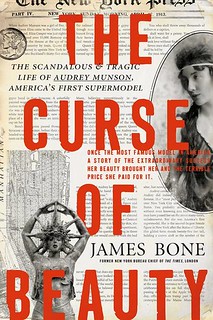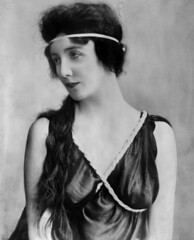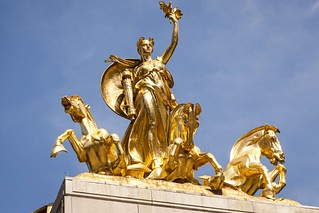
PREV ARTICLE
NEXT ARTICLE
FULL ISSUE
PREV FULL ISSUE
NEW BOOK: THE CURSE OF BEAUTY
A new book examines the life of Audrey Munson, the most famous artist’s model of the Gilded Age, was said to have been the model for the
Mercury dime and Walking Liberty half dollar. The Wall Street Journal published a review this week. -Editor
The Gilded Age model and silent-film star dated America’s richest bachelor, was the toast of the 1915 World’s Fair and inspired scores of painters and sculptors in the beaux-arts style. This proto-celebrity vanished long ago but her neoclassical features and figure live on in allegorical monuments and paintings across the United States. In a new biography, “The Curse of Beauty,” journalist James Bone investigates the tragic muse who bared it all, attempted suicide and spent almost 65 years in an asylum. Audrey’s parents separated when she was 6, and her mother, Kittie, served as chaperone and constant companion during her career.
For a decade, Audrey posed for photographs, illustrations, paintings and murals, as well as monuments, memorials and sculpture. In New York City, she is the unsung equivalent of France’s national symbol, Marianne. Audrey towers above the fountain by the Plaza Hotel and is immortalized in the sculptures “Descending Night,” by Adolph Alexander Weinman, and “Memory,” by Daniel Chester French, at the Metropolitan Museum of Art. She holds up a crown in “Civic Fame,” an allegorical female figure that stands 25 feet tall on the Manhattan Municipal Building, surpassed in size as a female figure in the city only by the Statue of Liberty. At the height of her celebrity, the former chorus girl dominated the World’s Fair in San Francisco. Then 24, she modeled for roughly three-quarters of the sculptures in the fair’s Jewel City exhibit. 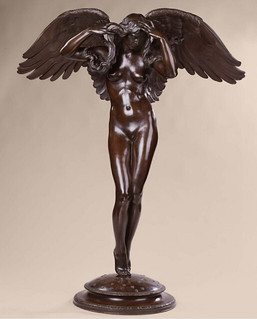 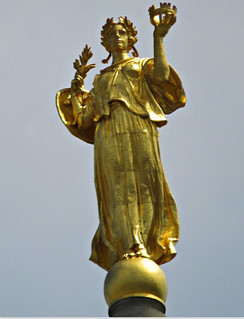
Munson modeled for "Descending Night" and "Civic Fame", both by artist Adolph Alexander Weinman To read the complete article, see:
Howard Daniel forwarded a related article from the New York Post about the life of "America's First Supermodel".
-Editor
She was known as “the most perfect model,” and in her heyday, one headline proclaimed, “All New York Bows to the Real Miss Manhattan.” She earned the name not just because she was the toast of the town in the 1910s, but because her perfectly proportioned face and body inspired numerous works of sculpture that still stand in Manhattan, Brooklyn and The Bronx today. One contemporary account concluded that Audrey Munson “posed for more public works than anyone” — at least a dozen of which are still on public display. New Yorkers may not know it, but they see Munson everywhere.
That’s her likeness lounging above the front door of the Frick and coyly tucked in a niche outside the New York Public Library’s main branch. She is the face of Pomona, the Roman goddess of abundance, on the Pulitzer Fountain at 59th Street and Fifth Avenue, across from the Plaza Hotel. “She was the first supermodel — and the first model to have a standing in society,” says Diane Rozas, co-author of “American Venus: The Extraordinary Life of Audrey Munson, Model and Muse.” To read the complete article, see:
We've discussed Audrey Munson before; she was mentioned by former Chief Engraver John Mercanti, where he'd stated that Munson was
a model for the Walking Liberty Half Dollar which in turn became the model for his American Eagle bullion coin. However, researcher Roger
Burdette noted that he'd "found nothing in Weinman's papers to indicate that he used any specific model for the half
dollar."
So why include this in The E-Sylum? Two reasons: First, it gives us a chance to discuss the attribution of Munson as a coin model; second, the new book sounds like a good read for serious numismatists regardless. Artists often use multiple models in their work, amalgamating features from each, so it may well be that Munson sat for Weinman at some point while he was working on his coin design. The book sounds like a great view into the art world of the Gilded Age when many of our greatest coin designers were active, including Weinman, Brenner and St. Gaudens. -Editor Roger Burdette adds: Add this nonsense to the bogus claimants for the "Indian" head cent, Morgan dollar, Standing Liberty quarter, Buffalo nickel obverse, Saint-Gaudens double eagle, and others. One can legitimately state that Adurey Munson modeled for Adolph Weinman at sometime or another. This is noted in his archival papers. Some of her body parts might be incorporated in his statue “Descending Night,” but the statue is not a likeness of Munson. Being an artist's model does not mean the model's likeness is on a completed work of art. Most art images are composites and only individual portraits - usually made on commission by the subject - are likenesses. Munson was among the bits and pieces from multiple models and ideas that resulted in the final artistic product. The "Mercury" dime is not a portrait of Elsie Stevens, but comparison of Weinman's portrait bust of her - which is an individual likeness - and the final coin design reveals many areas of agreement between the coin and the portrait. The artists' papers confirm her status as the primary source of the Liberty image. To read the complete article, see:
To read the earlier E-Sylum article, see:

Wayne Homren, Editor The Numismatic Bibliomania Society is a non-profit organization promoting numismatic literature. See our web site at coinbooks.org. To submit items for publication in The E-Sylum, write to the Editor at this address: whomren@gmail.com To subscribe go to: https://my.binhost.com/lists/listinfo/esylum All Rights Reserved. NBS Home Page Contact the NBS webmaster 
|
